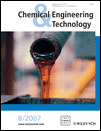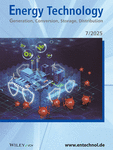Journal list menu
Export Citations
Download PDFs
Cover Picture
Cover Picture: Paint resin. © Edward Rozzo/Corbis Digital Stock (Chem. Eng. Technol. 8/2007)
- First Published: 20 July 2007
Overview
Contents
Forum
Scientific Highlights
Research Article
Solid Catalyst with Ionic Liquid Layer (SCILL) – A New Concept to Improve Selectivity Illustrated by Hydrogenation of Cyclooctadiene
- Pages: 985-994
- First Published: 20 July 2007
The hydrogenation of cyclooctadiene to cyclooctene and cyclooctane on a commercial Ni catalyst coated with the ionic liquid butyl-methylimidazolium-octylsulfate was used as a model system to demonstrate and test the novel concept of a solid catalyst with ionic liquid layer (SCILL). This SCILL concept is shown to have an interesting potential but also limitations.
Erratum
Photochemical Production of Vitamin D2, Scale-up and Optimization
- Page: 994
- First Published: 20 July 2007
Research Articles
Application of Interference Microscopy and IR Microscopy for Characterizing and Investigating Mass Transport in Nanoporous Materials
- Pages: 995-1002
- First Published: 20 July 2007
The application of interference microscopy has provided an important breakthrough in the study of the transport of guest molecules in nanoporous materials. This technique was used to study adsorption and desorption kinetics in several zeolite systems. The advantages of interference microscopy, especially when combined with infrared absorption measurements, are illustrated by experimental results obtained in a study of the methanol-ferrierite system.
Reduction of the Volatile Matter Evolution Rate from a Plastic Pellet during Bubbling Fluidized Bed Pyrolysis by Using Porous Bed Material
- Pages: 1003-1009
- First Published: 20 July 2007
Various porous bed materials are employed in fluidized bed experiments to evaluate the effect of volatile matter capture and heat transfer coefficient in the delay of devolatilization during heat up of plastic pellets. By employing porous solids without capacitance effect, the contributions of reduced heat transfer rate and capacitance effect to the delay of volatile matter evolution are separately evaluated.
Biomimetic Synthesis and Characterization of Mesoporous Titanium Dioxide
- Pages: 1010-1013
- First Published: 20 July 2007
Mesoporous TiO2 polycrystals of anatase and rutile phases are synthesized by a sol-gel method using PC as a biosurfactant. TEM, XRD N2 adsorption–desorption isotherms and UV-VIS spectroscopy studies confirm the synthesis of mesoporous TiO2.
Study of the Preparation of Flavone Imprinted Silica Microspheres and Their Molecular Recognition Function
- Pages: 1014-1019
- First Published: 20 July 2007
Molecularly imprinted silica microspheres are prepared via a two-stage reaction using luteolin as the template molecule. This microspheric adsorbent is seen to have a high adsorption capacity to the template molecule, high adsorption selectivity and reproducibility and does not show the problems of silica micro-spheres prepared by other methods, e.g., irregular and nonunifom appearance, residues and low operability.
Gas Hold-Up Evaluation Using the Analytical Solution of the Axial Dispersion Model: Comparison with Static Measurement Results
- Pages: 1020-1027
- First Published: 20 July 2007
The gas hold-up is determined in an aerated, stirred vessel with two methods, namely by visual evaluation of the liquid level rise and by processing the gas RTD curves. In turn, the second approach is developed by calculating the mean residence time directly from the curves and by fitting them with the one-dimensional dispersion model and calculating the mean residence time by means of the model analytical solution.
Investigation of the Effect of a Dividing Wall in a Moving Bed
- Pages: 1028-1035
- First Published: 20 July 2007
A perforated dividing wall is located in a two-dimensional rectangular moving bed with gas cross-flow and the effect of the wall on properties of the moving bed such as cavity formation and pinning is investigated. In comparison to a moving bed without a dividing wall, the cavity size and pinning width in a moving bed with a dividing wall are smaller at the same gas velocity.
Velocity Profiles of Suspension Flows through an Abrupt Contraction Measured by Magnetic Resonance Imaging
- Pages: 1036-1044
- First Published: 20 July 2007
Solid particle suspen-sions are of great interest in several industrial processes, such as polymer processing and paper manufacturing. The velocity profiles of particle suspen-sions at high volume fractions subjected to steady shear and elongation through a duct with an abrupt contraction using magnetic resonance imaging (MRI) velocimetry are obtained.
Aggregation Experiments on Fine Fly Ash Particles in a Gradient Magnetic Field
- Pages: 1045-1049
- First Published: 20 July 2007
Aggregation experi-ments are conducted on two kinds of fly ash particles in a gradient magnetic field produced by permanent magnetic rings. The effect of particle size, total particle mass concentration, particle residence time in the magnetic field and gas velocity are reported, and the removal efficiencies in a gradient magnetic field are seen to be much higher than those in a uniform magnetic field.
Estimation of Ultrafilter Performance Based on Characterization Data
- Pages: 1050-1054
- First Published: 20 July 2007
Limiting concentration for the planned filtration dewatering of high-level radioactive waste can be approximated by the centrifuged solids concentration. Simulated sludge phases as well as actual waste samples were used to validate a concentration polarization model at high solids concentrations.
Calcium-Ion Removal from Peat by a Mechanical Filter Cake Washing Process
- Pages: 1055-1061
- First Published: 20 July 2007
Peat is a natural product which can be used for water treatment, medicines, fuels and cosmetics. The applicability of a mechanical purification process for ion removal from the porous peat structure may open new opportunities for local peat decontamination offering new applications as a high quality product.
Enhancement of Methanol Production in a Membrane Dual-Type Reactor
- Pages: 1062-1076
- First Published: 20 July 2007
The development of a membrane-based process could open the way to increasing the methanol production in the methanol synthesis process. In this work, the performance of a membrane dual-type reactor system was compared with a conventional dual-type and a single-type reactor for methanol synthesis.
Flow Regime Transitions in an Internal-Loop Airlift Reactor
- Pages: 1077-1082
- First Published: 20 July 2007
The flow regime transitions of the riser and downcomer in an internal-loop airlift reactor are investigated. The determination of chaotic invariants, e.g., the correlation dimension and the largest Lyapunov exponent, predicts for the first time that there is no heterogeneous phase existing in the downcomer of an internal-loop airlift reactor.
Photocatalytic Degradation of Benzene in Air Streams in an Optical Fiber Photoreactor
- Pages: 1083-1087
- First Published: 20 July 2007
The quantum yield for the photocatalytic decomposition of benzene in an optical fiber TiO2 photocatalytic reactor was measured. The effects of humidity, benzene and UV light intensity on the reactor efficiency were quantified. The results show that optical fiber reactors are more efficient than fixed-film photoreactors.
Study of Ethylene Polymerization Under Single Liquid Phase and Vapor-Liquid Phase Conditions in a Continuous-Flow Tubular Reactor
- Pages: 1088-1093
- First Published: 20 July 2007
The viability of using continuous flow tubular reactors as an efficient research tool for polymerization reactions is investigated. The effect of operating conditions and flow composition on the molecular weight of the polymer are studied. The existence of liquid and vapor phases provides an almost constant ethylene concentration along the length of the reactor, which significantly affects the polymer molecular weight.
Optimization of Carbon Dioxide Fixation by Chlorella vulgaris Cultivated in a Membrane-Photobioreactor
- Pages: 1094-1099
- First Published: 20 July 2007
A membrane-photo-bioreactor is seen to greatly enhance the mass transfer rate of CO2 and O2. The capability of CO2 removal is strongly dependent on the conditions of feed gas, light and the membrane module, when CO2 is fixed by Chlorella vulgaris in a membrane-photobioreactor. The principle of this photobioreactor design is of great interest for both algal cultiva-tion and gas removal applications.
Combining Models ADM1 and ASM2d in a Sequencing Batch Reactor Simulation
- Pages: 1100-1112
- First Published: 20 July 2007
The Anaerobic Diges-tion Model No. 1 and the Activated Sludge Model No. 2d have been com-bined in a sequencing batch reactor simulation using a FORTRAN ODE solver. Special attention has been paid to the interface definition between the two models. The simulation results demonstrate the alternating treatment characteristics resulting from the sequence of anaerobic and aerobic steps. A parameter study reveals the process optimization potential of the model.
Decomposition of a Lignin Model Compound under Hydrothermal Conditions
- Pages: 1113-1122
- First Published: 20 July 2007
Lignin has been proposed as an alternative source of chemical compounds. Guaiacol, a model compound for lignin, is reacted in supercritical water using a batch-type reactor and a reaction mechanism for the decomposition of guaiacol is proposed. The process investigated in this study may form the basis for an efficient method of wood biomass decomposition.
Kinetic Study of Nickel Oxide Reduction by Methane
- Pages: 1123-1128
- First Published: 20 July 2007
The thermogravimetric technique is used for the determination of kinetic parameters for the reduction of nickel oxide pellets, NiO, by methane. The conversion-time data have been interpreted by using the grain model. This faster reduction in comparison with thermal carbon reduction is attributed to the high carbon activity in methane.
Communications
Induction Time of Reaction Crystallization of Silver Nanoparticles
- Pages: 1129-1133
- First Published: 20 July 2007
Synthesis of silver nano-particles on an industrial scale has many challenges despite its promising future. The key factor that controls the size of silver nanoparticles is crystallization kinetics. This paper reports a kinetic study on the deter-mination of induction time in the framework of classical nucleation theory.
Prediction via Neural Networks of the Residual Hydrogen Peroxide used in Photo-Fenton Processes for Effluent Treatment
- Pages: 1134-1139
- First Published: 20 July 2007
The use of neural networks in the prediction of residual concentrations of hydrogen peroxide is proposed for the treatment of efflu-ents via the photo-Fenton process. The results of the residual concentration are modeled via a feedforward neural net-work, with the correlation coefficients between actual and predicted values above 0.96, indicating good prediction capacity.










